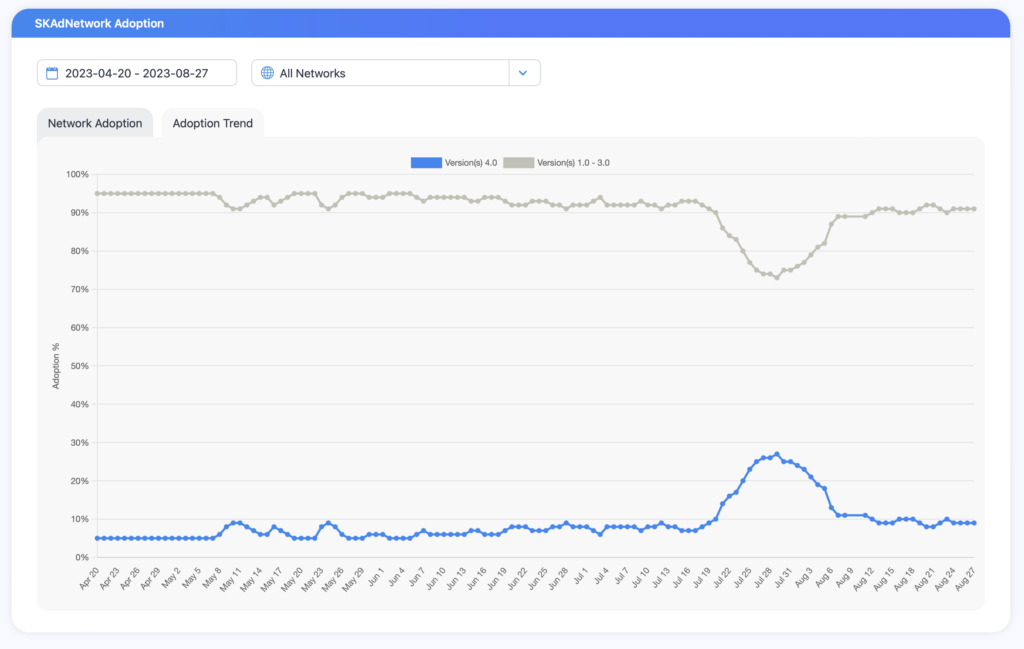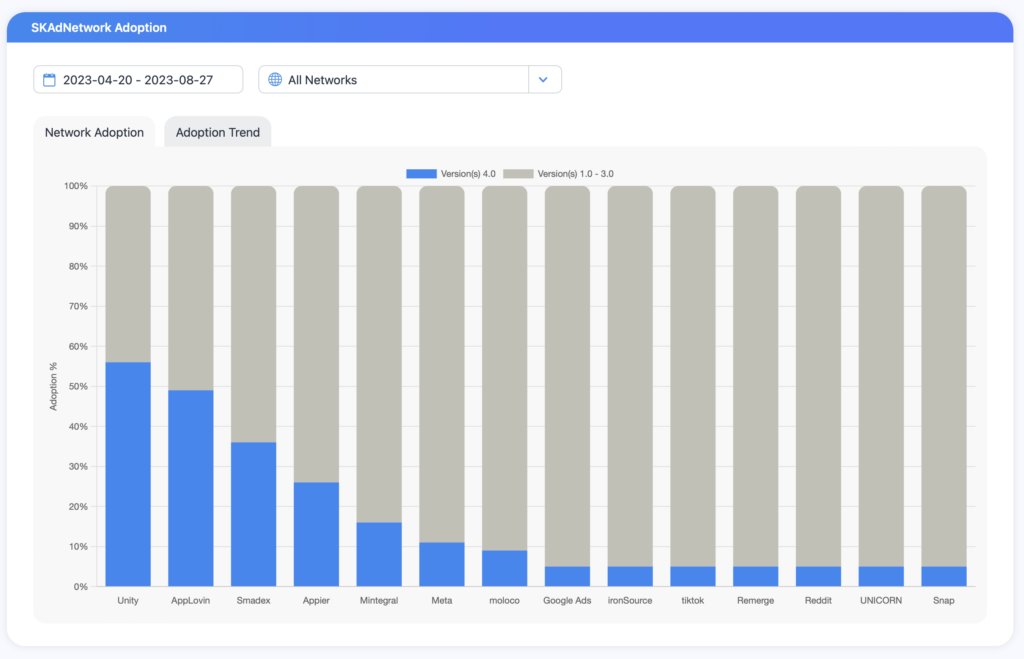When will SKAN 4 adoption start growing again?
SKAN 4 adoption is now the lowest it has been since May of this year, almost 4 months ago. After a high of 27% on July 29, SKAN 4 postbacks now make up only 9% of all mobile app install postbacks Singular is measuring.
What’s going on?
And when will SKAN 4 adoption start growing again?

SKAN 4 high water: July 2023
The SKAN 4 high water mark was July 29. Applovin, Meta, Unity and other platforms had just migrated to a significantly larger percentage of SKAN 4 postbacks and I called it the SKAN 4 inflection point:
Since May 9, SKAN 4 adoption has been hovering around the 10% mark. It’s been a phase of testing, analyzing, refactoring, and optimizing for pretty much all the major ad networks and platforms.
But on July 18th, we saw significant movement that has turned into an emerging trend line: the SKAN 4 inflection point. The most recent data indicates we hit 23% SKAN 4 postbacks industry-wide, with no signs of slowing down.
If I’m going to be generous with myself, it was perhaps a SKAN 4 inflection point, but it will not (hopefully) be the SKAN 4 inflection point. As we all know by now, the SKAN 4 CV reset bug, which had probably been hiding in plain sight inside an Apple Search Ads function for months if not years, suddenly became very obvious, resetting SKAN 4’s fine conversion values to zero and coarse conversation values to “none.” The vector for the bug to activate was one of the new capabilities SKAN 4 brought to SKAdNetwork: the ability to decrement conversion values as well as increment them.
The result was catastrophic: loss of attribution signal.
By good luck or skill Singular’s SDK was immune on its own, but third-party SDKs could still decrement values for Singular customers, and other MMPs’ SDKs were not immune.
Back to low water … 9% SKAN 4 (but not for all)
Since most of the biggest platforms have either reverted their migration to SKAN 4 or never began it after hearing about the bug, SKAN 4 adoption is now a third of what it was a month ago. That feels like reverse migration, but of course there is no point sending out postbacks whose payloads will get zeroed out.
The interesting thing is that not all big ad networks have fully reverted their SKAN 4 migration. If you check Singular’s SKAN 4 adoption dashboard by network adoption, you’ll notice a few outliers.

Unity is still up over 50% SKAN 4 still. AppLovin is very close to 50%. Smadex is at 36% SKAN 4, while Appier and Mintegral are at 26% and 16%. Even Meta, which triggered the inflection point, is still over 11% SKAN 4 postbacks.
There are a number of possible reasons here:
- Unlikely
This is Singular data; Singular is not directly impacted by the SKAN 4 CV reset bug; these networks could be firing more SKAN 4 postbacks for Singular clients than others. - Unlikely
MMPs impacted by the bug have quickly solved it; other SDKs that were impacted have done so as well, so the networks can keep a higher percentage of SKAN 4 than you might think. - Likely
Some networks are running measurement, analytics, and optimization on non-SKAN data and are therefore not (solely) relying on SKAN 4 postback payloads to target and tweak. - Likely
Since everyone except Unity is under 50% SKAN 4, many are using SKAN 3 plus their internal data to improve campaign performance.
So when will SKAN 4 adoption start growing again? When will we have our next SKAN 4 inflection point?
Apple has fixed the SKAN 4 bug already. That’s not the problem.
The problem is that we need the universe of iOS users to update to a newer version of iOS that carries the fixed SKAdNetwork framework code. And that could be from 1 to 3 months.
As we mentioned earlier this month, it took from April through May and June and all the way to July to get iOS 16.5 to nearly 55% of devices. But 2 of those months were to get from 0% to 2.72%. For big changes, Apple takes its time to roll out updates to the hundreds of millions of iOS users.
From that sub-3% level, however, it was just 1 month to 43.17%. So when Apple’s pretty certain about the quality of a release, it can get hundreds of millions of iPhones updated globally very quickly.
The next big iOS release is iOS 17. (I’m on the public beta, and it’s really good.) Announced at WWDC this year in June, it’s likely to be released in September. That’s not based on insider information, by the way, but history. Here’s a list of previous iOS update release dates in September, via 9TO5Mac:
- iOS 16: September 12, 2022
- iOS 15: September 20, 2021
- iOS 14: September 16, 2020
- iOS 13: September 19, 2019
- iOS 12: September 17, 2018
So, it’s not written in tablets of stone, but we’ll likely see an iOS 17 release in September unless major issues come up. The SKAN 4 fix is already out in iOS 16.6, but not everyone upgrades for point releases. It’s more common for the bulk of the iPhone and iPad fleet to get updated soon after major software releases with new features that Apple customers want to experience.
Which means we should see the SKAN 4 numbers start to go up in late September and through October.
At least, that’s my bet for the next big SKAN 4 inflection point.
Stay up to date on the latest happenings in digital marketing


